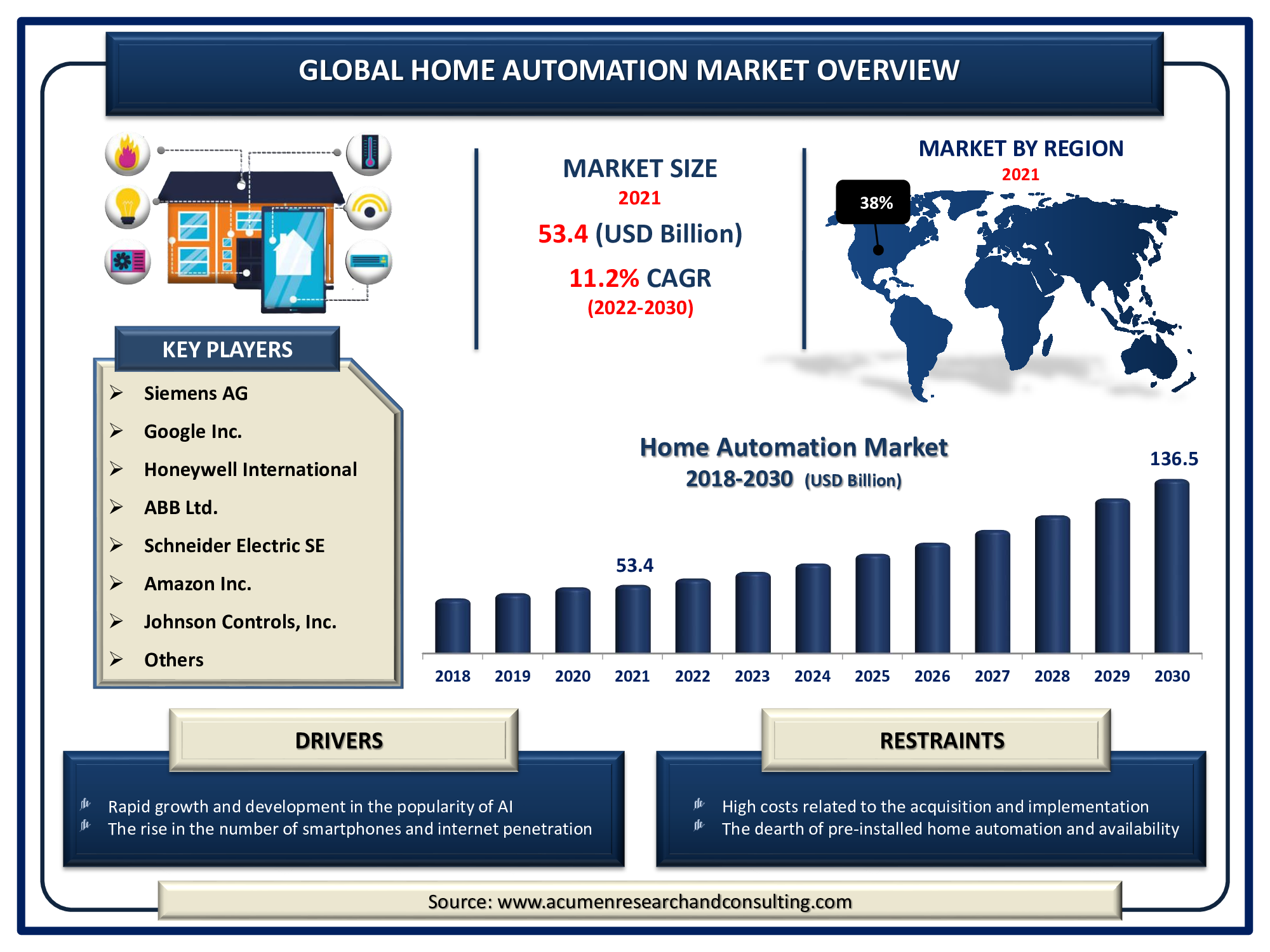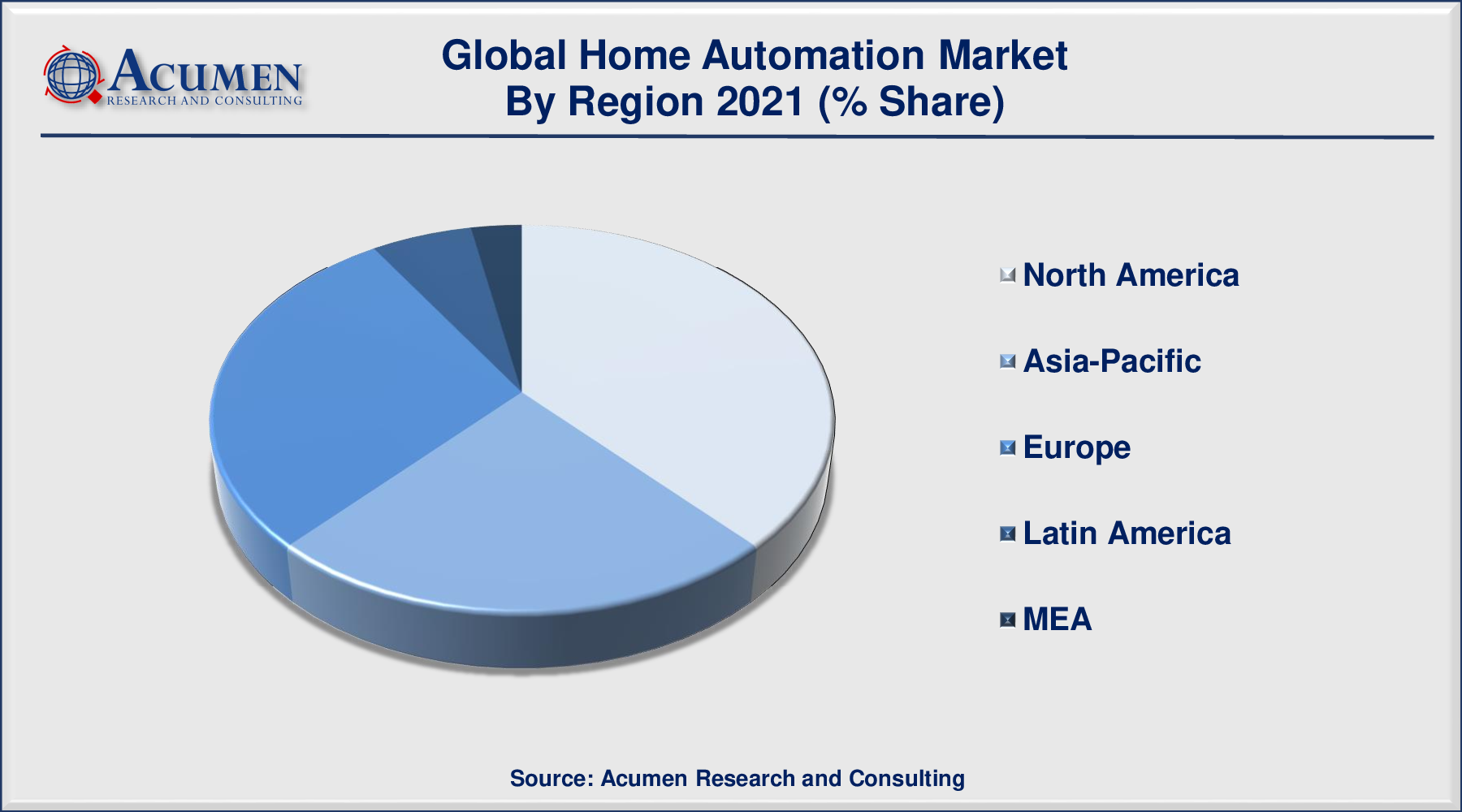December 2023
Home Automation Market size Accounted for USD 53.4 Billion in 2021 and is predicted to be worth USD 136.5 Billion by 2030, with a CAGR of 11.2%
The Global Home Automation Market size Accounted for USD 53.4 Billion in 2021 and is predicted to be worth USD 136.5 Billion by 2030, with a CAGR of 11.2% during the projected period from 2022 to 2030.

Home automation delivers high-end solutions and automates our products and systems with advanced digital technologies. Home automation provides better efficiency and improved performance to automate the system's domestic and household activities. Consumers want to customize, professional systems that are easy to use and installed.
Building automation industry developments, which saw the introduction of advanced technology and equipment, also called smart home and intelligent building, have changed the way products and services are delivered. These technologies have been the center of continuous research and development in order to compatibilize the product with Smart & Sustainable Home and Building projects with a focus on improving consumer experience. The global adoption of domestic controls increased technological advances and improved connectivity solutions. The installation of automated control systems has been simplified with the advent of different wireless technologies such as ZigBee and Bluetooth. The adaptability of different components with each other has been increased by different standards for home automated controls such as EnOcean and Z-waves. Further improvements of the automation systems in various end user segments are expected to fuel their adoption.
Global Home Automation Market DRO’s
Market Drivers
Market Restraints
Market Opportunities
Home Automation Market Report Coverage
| Market | Home Automation Market |
| Home Automation Market Size 2021 | USD 53.4 Billion |
| Home Automation Market Forecast 2030 | USD 136.5 Billion |
| Home Automation Market CAGR | 11.2% During 2022 - 2030 |
| Analysis Period | 2018 - 2030 |
| Base Year | 2021 |
| Forecast Data | 2022 - 2030 |
| Segments Covered | By Application, By Technology, By Channel, And By Region |
| Regional Scope | North America, Europe, Asia Pacific, Latin America, and Middle East & Africa |
| Key Companies Profiled | Honeywell International Inc., Crestron Electronics, Inc., United Technologies Corporation, ABB Ltd., Schneider Electric SE, Amazon Inc., Savant Systems LLC, Johnson Controls, Inc., Siemens AG, Ingersoll-Rand plc, Legrand SA, ADT LLC, Lutron Electronics Co., Google Inc., AMX LLC, Control4 Corporation, 2GIG Technologies, Inc, and SmartThings Inc. |
| Report Coverage |
Market Trends, Drivers, Restraints, Competitive Analysis, Player Profiling, Regulation Analysis |
The most important motivators driving growth in the home automation market are increasing demand for smart phone-based home automation applications, increasing consumer awareness about energy consumption products, technologic advances, convenience factor, fast mobile connectivity, urbanization and lifestyle changes. As home automation provides security, safety and advanced technology, demand has increased for home automation. The smart domestic automation market over the forecast is expected to be driven mainly by the increasing demand for digital features, such as remote operation convenience, with advanced technological devices, and the increasing impact of the web, mainly in the developing world. Moreover, the growing demand for smart home automation global markets in the coming years will also increase the available income plus increased preference for priceless lives in developing economies.
In addition, the cost reduction measurements that also develop demand for market in both developed and developed economies facilitate smart home automation systems. Home automation involves the implementation of certain electronics and electrical systems in a degree of automation and computerized control. These devices include garage doors, safety systems, control of temperature, video / audio equipment, electronic doors and lighting. The system can be operated by devices such as laptop or Mobile Telephone that are enables Wi-Fi or Bluetooth, whereas a desktop computer is a server. Hardware costs, as are the hardware required for most users, and installation costs are considerably low. The home automation solution satisfies different applications ' interoperability requirements and is at the same time easy to use and install. The biggest driver is expected to be the increase in the aging population. The market's growth can be challenged by high initial installation or installation costs and lack of standard guidelines. However, this challenge could be overcome by the corresponding decline, price and increase in home automation. Growing consumer electronics interests, increasing consumer availability income, introducing smart grids and helping to communicate power line are some of the factors which can drive growth in the market positively. But unethical technological violations, a lack of consumer awareness and skills could pose a challenge for the growth of the market.
Home Automation Market Segmentation
The global home automation market segmentation is based on the application, technology, channel, and geographical region.
Market by Application
According to the home automation market forecast, the entertainment system segment will grow at the strongest rate in the market over the next few years. It can regulate television and multimedia sources. This can be related to the expanding number of options accessible on the marketplace, such as Amazon Echo, Google Home, and so on, as well as consumers' willingness to purchase them.
Market by Technology
.png)
Based on technology, the wireless segment is expected to increase significantly in 2021. This is related to the increased popularity of wireless systems for home automation and the ease of installing them as well as using them. Furthermore, wireless smart home devices with IoT are a cutting-edge the internet of things applications intended to manage household appliances remotely via the web application.
Market by Channel
According to the home automation industry analysis, the mainstream segment is expected to account for a significant market share in 2021. This is owing to the increasing cost and simplicity of such systems for home automation. Such systems provide consumers with protection, convenience, comfort, as well as energy consumption by leveraging the growing ubiquity of gadgets, which are typically controlled via a single code base on their smartphones or even other connected technologies.
Home Automation Market Regional Outlook
North America
Europe
Asia-Pacific
Latin America
Middle East & Africa

Home automation Market Regional Insights
Asia Pacific is an important part of the worldwide plastic conductive compound market, with a significant market share. The growing adoption of home automation in electrical applications is one of China's main consumers of home automation. The country is also one of the leading manufacturers of plastic leading compounds. The marketing of leading plastic compounds in Asia Pacific should be driven by the presence of big electrical and electronic component manufacturers and various small domestic manufacturers of plastic compound in that region. The transition to East Asia from the western hemisphere of production capabilities of electrical components and electronic devices is expected to boost demand for leading plastic compounds. Moreover, in several end-use industries in this region, plastic compounders expand their production facilities to meet the growing demand for conducting plastics compounds. The rapid industrialization and expansion of production sites with electric and electronic components are planned to propel demand for conductive plastics in India, South Korea, Thailand and Vietnam. The impact of ongoing research and development activities in North America and Europe between universities and plastic converters is high. Consequently, in North America and Europe, the market for conducting plastic compounds is likely to expand rapidly during the predicted period.
Home Automation Market Players
Some of the prominent global Home Automation market companies are Honeywell International Inc., Crestron Electronics, Inc., United Technologies Corporation, ABB Ltd., Schneider Electric SE, Amazon Inc., Savant Systems LLC, Johnson Controls, Inc., Siemens AG, Ingersoll-Rand plc, Legrand SA, ADT LLC, Lutron Electronics Co., Google Inc., AMX LLC, Control4 Corporation, 2GIG Technologies, Inc, and SmartThings Inc. The market for home automation is moderately fragmented and extremely competitive. The future market will be driven in the near future by ongoing research and development in home automation.
With the attendance of many small and medium-sized manufacturers, the market is fragmented. The strong presence of local manufacturers and suppliers is one of the main reasons for market fragmentation. In addition, companies focus on product adaptation, strategic partnerships and new customer acquisitions to gain more market shares.
Looking for discounts, bulk pricing, or custom solutions? Contact us today at sales@acumenresearchandconsulting.com
December 2023
January 2023
July 2022
July 2022